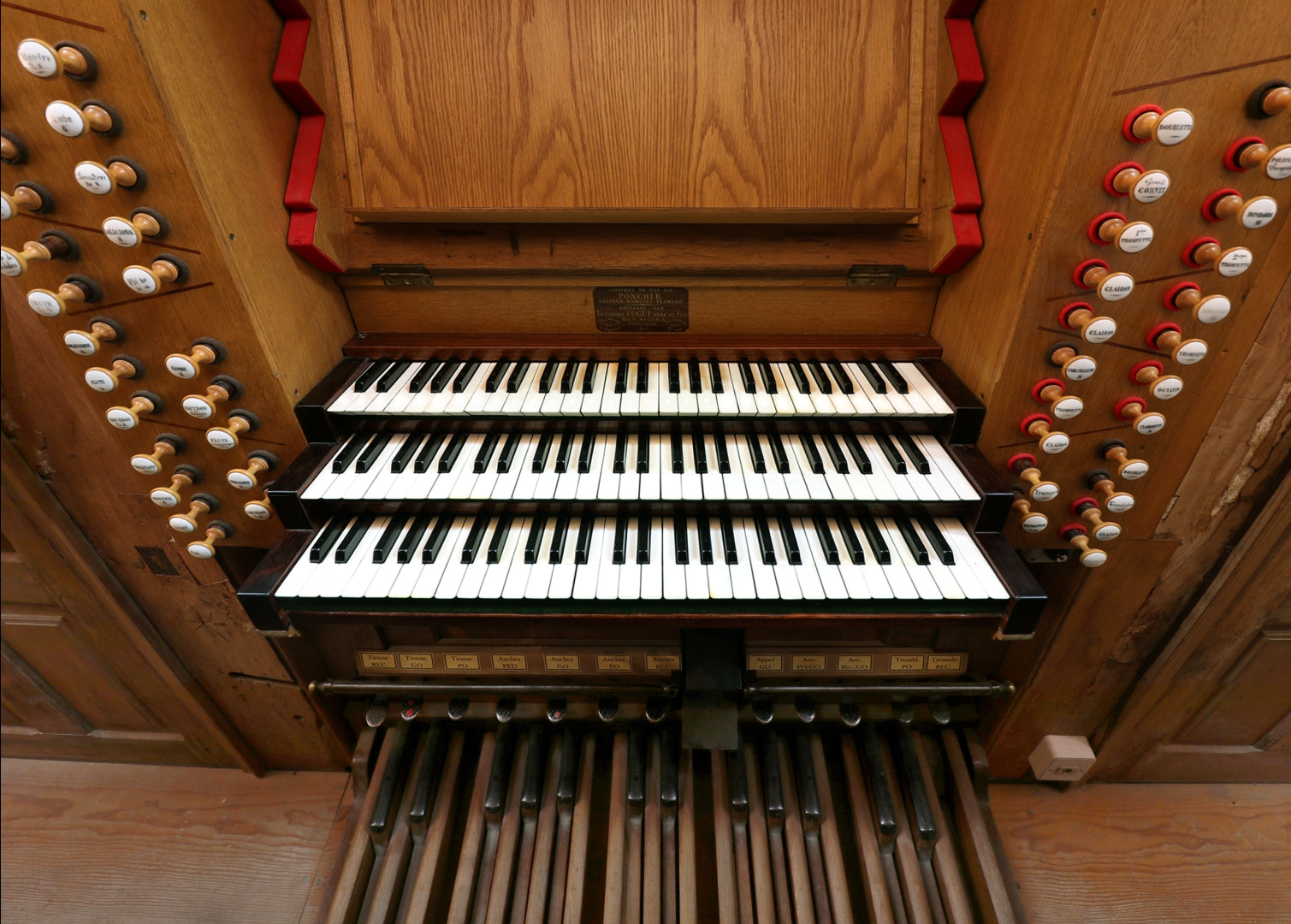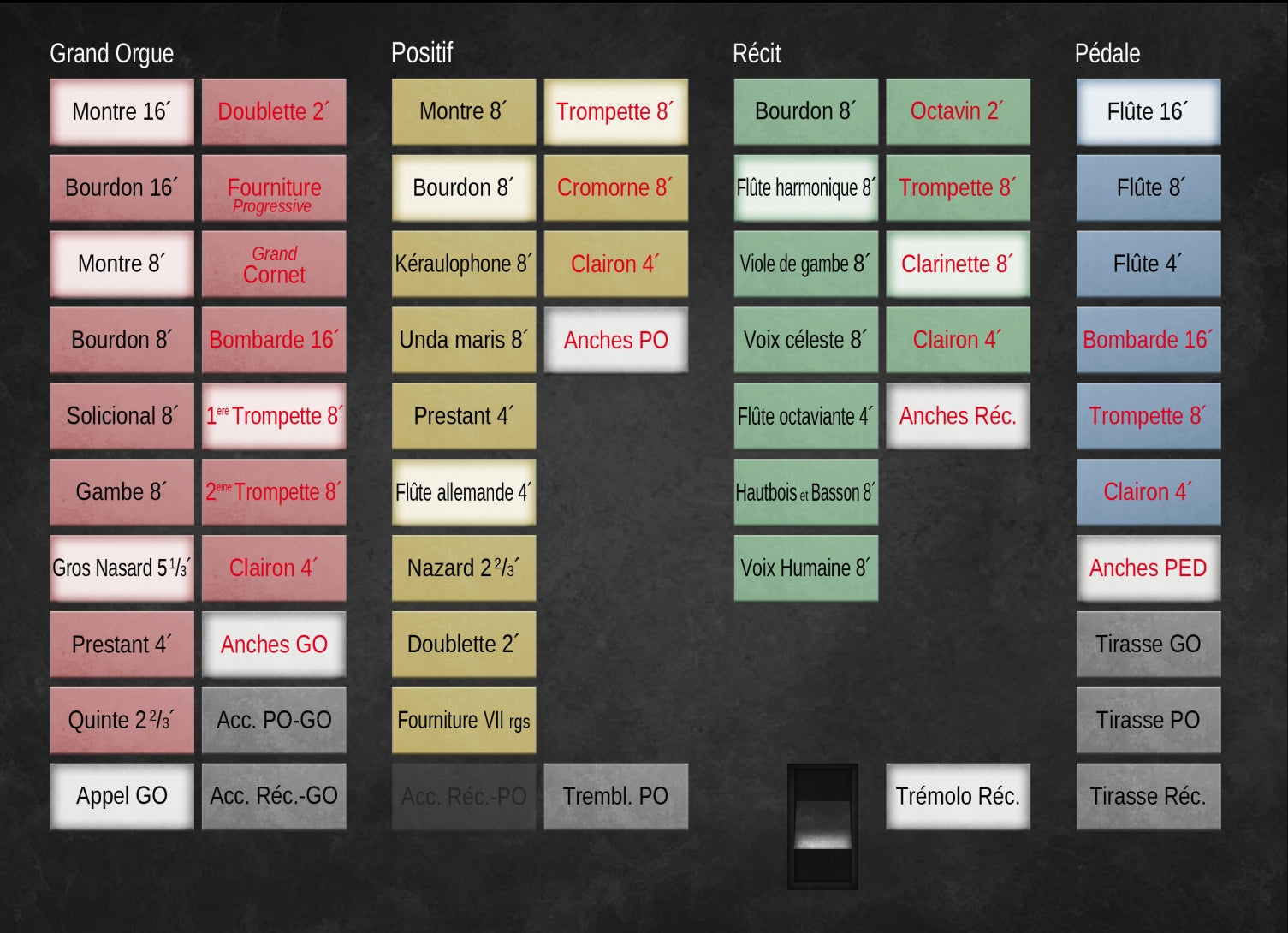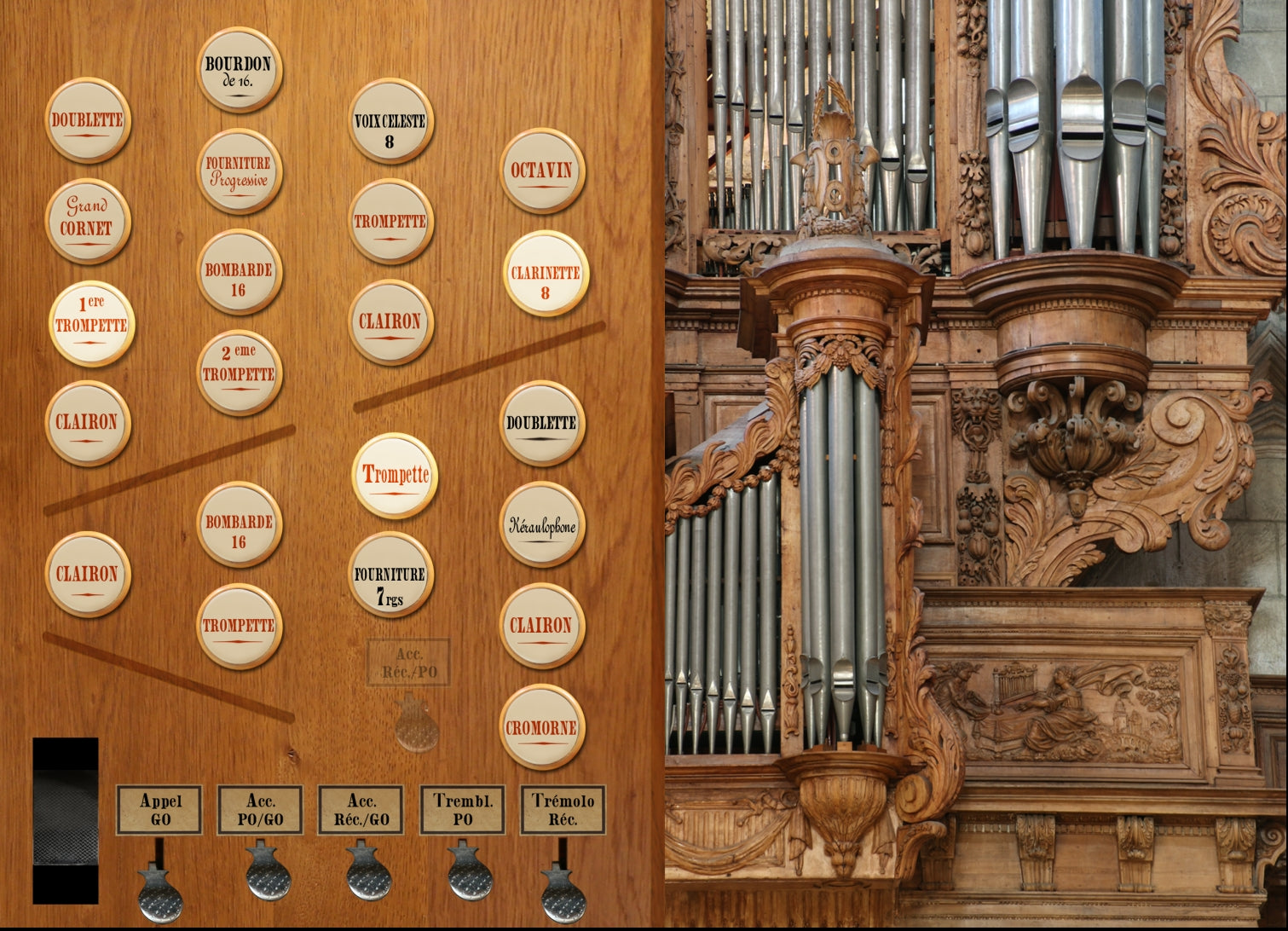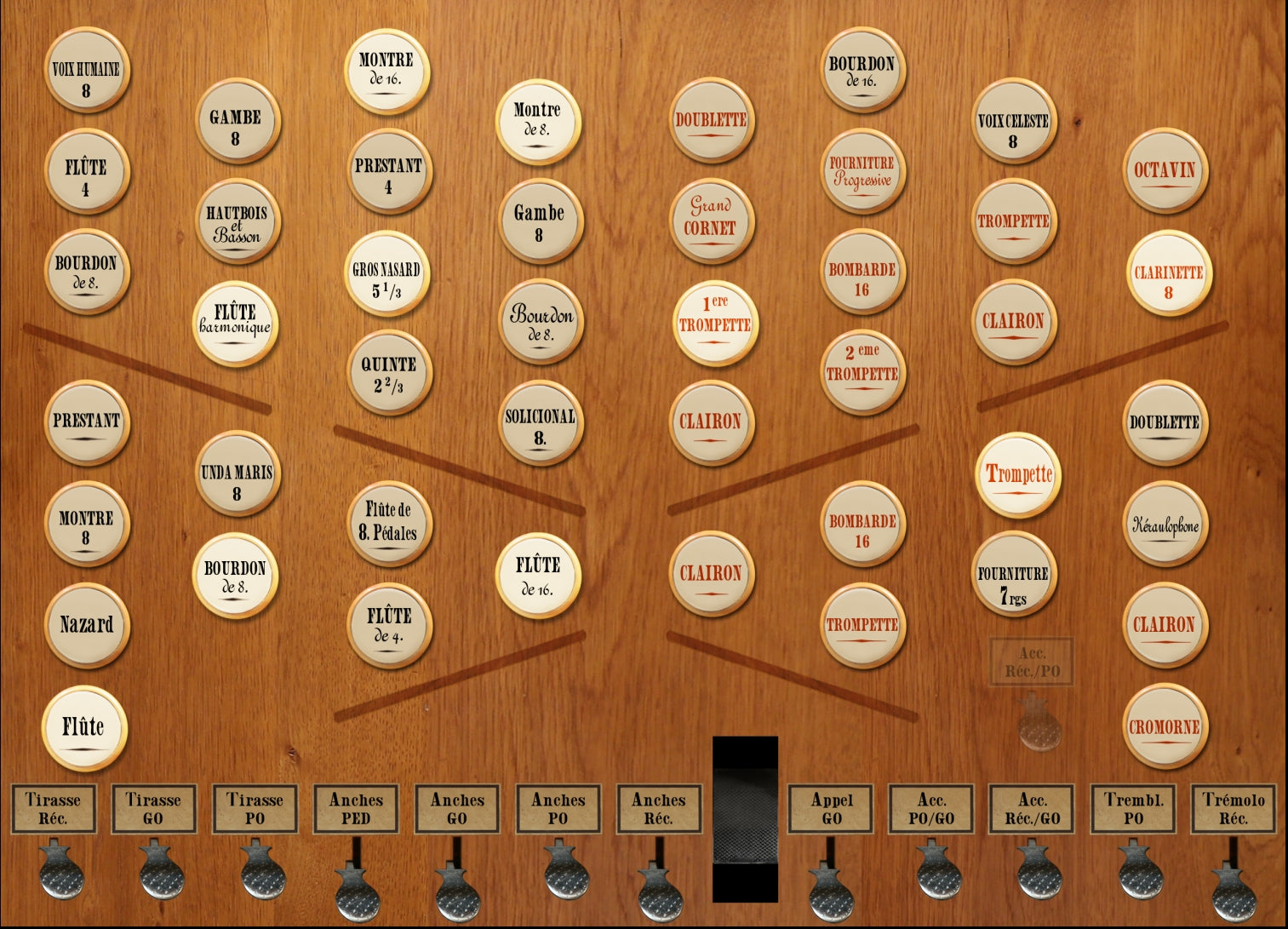Sonus Paradisi
Beziers Cathedral Puget [Hauptwerk]
Beziers Cathedral Puget [Hauptwerk]
Couldn't load pickup availability
Béziers Cathedral Organ
The organ has 45 stops, 59 ranks, on 3 manuals of 54 notes and a 30-note pedalboard. The console layout is by Théodore Puget, with Grand Orgue being the first (lowest) manual, then the Positif and finally the Récit expressif. Key action is mechanical, with Barker pneumatic assistance for the G.O. and its couplers.
The pipework is quite disparate, with pipes by:
Poncher - G.O. Montre facade pipes, and other six stops: Cornet, Bourdon 8', bass of Doublette in the G.O.; Flûte 4', bass of Nazard and bass of Doublette in the Positif
de Joyeuse - top of the Voix humaine in the Récit and Trumpet in the Pos.
Monturus - facade pipes of the Positif Montre, wooden bass of the G.O. Bourdons 16' and 8' and of the Positif Bourdon 8' and a few pipes in the Flûte 8' de Pédale
Isnard - oboe in the Récit from C3
Chambry - principal chorus of G.O. and Positif
Cavaillé-Coll (Solicional 8' in the G.O. and Trompette in the Récit)
Puget - all remaining pipework, plus he revoiced the complete instrument to bring it to a coherent whole.
Presented to you by Leonart Studio, your authorised reseller for Sonus Paradisi in Switzerland (shipped internationally). Get your digitally sampled historical organs for the use with the Hauptwerk virtual instrument software.
Share this Sample Set
![Beziers Cathedral Puget [Hauptwerk]](http://artful.shop/cdn/shop/files/beziers1.jpg?v=1759144296&width=1445)
![Beziers Cathedral Puget [Hauptwerk]](http://artful.shop/cdn/shop/files/beziers2.jpg?v=1759144294&width=1445)
![Beziers Cathedral Puget [Hauptwerk]](http://artful.shop/cdn/shop/files/beziers3.jpg?v=1759144293&width=1445)
![Beziers Cathedral Puget [Hauptwerk]](http://artful.shop/cdn/shop/files/beziers4.jpg?v=1759144292&width=1445)
![Beziers Cathedral Puget [Hauptwerk]](http://artful.shop/cdn/shop/files/beziers5.jpg?v=1759144295&width=1445)
![Beziers Cathedral Puget [Hauptwerk]](http://artful.shop/cdn/shop/files/beziers6.jpg?v=1759144291&width=1445)
![Beziers Cathedral Puget [Hauptwerk]](http://artful.shop/cdn/shop/files/beziers7.jpg?v=1759144293&width=1445)
![Beziers Cathedral Puget [Hauptwerk]](http://artful.shop/cdn/shop/files/beziers8.jpg?v=1759144293&width=1445)
![Beziers Cathedral Puget [Hauptwerk]](http://artful.shop/cdn/shop/files/beziers9.jpg?v=1759144292&width=1445)
![Beziers Cathedral Puget [Hauptwerk]](http://artful.shop/cdn/shop/files/beziers10.jpg?v=1759144292&width=1445)
![Beziers Cathedral Puget [Hauptwerk]](http://artful.shop/cdn/shop/files/beziers11.jpg?v=1759144292&width=1445)
![Beziers Cathedral Puget [Hauptwerk]](http://artful.shop/cdn/shop/files/beziers12.jpg?v=1759144293&width=1445)
Specification (stop list)
-
Manual I
I Grand-orgue 54 notes
Montre 16’
Bourdon 16’
Montre 8’
Bourdon 8’
Solicional 8’
Gambe 8’
Gros nazard 5 1/3’
Prestant 4’
Quinte 2’2/3
Doublette 2’
Fourniture II à IV rgs
Grand cornet V rgs
Bombarde 16’
1re Trompette 8’
2e Trompette 8’
Clairon 4' -
Manual II
II Positif 54 notes
Montre 8’
Bourdon 8’
Kéraulophone 8’
Unda Maris 8’
Prestant 4’
Flûte allemande 4’
Nazard 2′2/3
Doublette 2′
Plein-jeu III à VIII rgs
Trompette 8′
Cromorne 8′
Clairon 4'
-
Manual III
III Récit expressif 54 notes
Bourdon 8’
Flûte harmonique 8’
Viole de gambe 8’
Voix céleste 8’
Flûte octaviante 4’
Octavin 2′
Trompette 8′
Basson-Hautbois 8’
Voix humaine 8’
Clarinette 8’
Clairon 4'
-
Manual IV
-
-
Pedal
Pédale 30 notes
Flûte 16’
Flûte 8’
Flûte 4’
Bombarde 16’
Trompette 8′
Clairon 4’
-
Other specification
Couplers: Pos./G.O. , Réc./G.O. (Réc/Pos. added in Hauptwerk), G.O./Péd., Pos./Péd. ,Réc./Péd.
Appels (enables stops in red): G.O., Pos., Réc., Péd.
Tremulants for Pos. and Réc.
History
A contract for the construction of a new organ in Béziers Cathedral was signed on September 28, 1623 with Flemish organ builder Guillaume Poncher. The organ had two manuals; a Grand Orgue based on a 16' Montre, with a smaller positif. There was also a 19-note Pédale with just one 16' wooden stop. The organ and its gallery were completed in 1633 and they have been preserved until today, including their splendid and rich decoration. In 1680, Jean de Joyeuse repaired the bellows, modified and added various stops, and enlarged the Pédale. In 1775, Guillaume Monturus made a repair and further modifications. Some of his pipes still exist today, especially the Positif Montre. Later, Joseph Isnard and Jean-François L'Épine worked on the instrument. The instrument suffered damage during the French Revolution, when almost all the pipes of the Grand Orgue were lost.
The organ loft and case were listed as historic monuments in 1840. In 1841, Nicolas Chambry was commissioned to rebuild the organ. The organ was enlarged to 5 manuals but remained based on 18th-century models, with a pedalboard that included a grand ravalement to F0. In 1849, Aristide Cavaillé-Coll was called to bring the instrument up to date. But Cavaillé-Coll's plans to improve the organ were hampered by the limited resources available to the organ committee, and in 1868, a new reconstruction was entrusted to the Théodore Puget et fils factory from Toulouse. He radically transformed the organ into a Romantic instrument. He provided new windchests, new bellows, three highly differentiated Romantic-style divisions. However, he respected the old pipework, particularly that of the Positif that was still made up mainly of old pipes. In 1881, Eugène Puget slightly modified the composition to bring the instrument into line with symphonic aesthetics.
In 1930, Maurice Puget increased the number of stops from 45 to 50, the range of the keyboards from 54 to 56 notes and the pedalboard from 27 to 30 notes. Full restoration of the instrument was completed in 1993 by Manufacture Languedocienne de Grandes Orgues under the artistic direction of Georges Danion and voicing by Jacques Bertrand. The instrumental section of the organ was listed as a historic monument on March 11, 1986. The consultants, Xavier Darasse and Jean-Pierre Decavèle, opted for a return to the 1868 composition, while retaining the reed stops rebuilt in 1881. The inauguration took place on February 20 and 21, 1993, by Marie-Claire Alain and André Isoir.
Features
Encryption
The samples are offered in 48kHz/24bit resolution. The multiple releases have three levels: short, mid and long. Hauptwerk v4.2 and higher supported. The sample set is offered in a plain wave format, no encryption.
Reverb time
The reverb time is ca. 4 seconds.
Keyboards, pedalboard
The original compass of the keyboards is 54 keys, extendable to 56 keys via a mixer switch. The original compass of the pedal division is 30 keys, extendable to 32 keys via a mixer switch.
Tremulants
All ranks of the Positif and Récit were recorded with and without tremulants for the most convincing tremulant behavior. It is possible to select to use the artificial tremulant instead if desired (the switch is located on the mixer tab).
Surround format
The sample set is offered in a Surround variant (6 channels). There are direct channels, diffuse channels, and rear channels. To reproduce the surround format, an audio card with at least 4 output channels is required, dedicating the direct and diffuse channels for the front speakers, and other two channels for the rear speakers.




Requirements
Hauptwerk v4.2 and higher supported. The sample set is offered in a plain wave format, no encryption.
RAM consumption: 6-channel surround
16-bit, other settings default: 24 GB
20-bit, other settings default: 40 GB
24-bit, other settings default: 46 GB
Screen resolution 1280x1024 px or more.
Polyphony of 8.000 voices recommended for the full suround.
This Hauptwerk Sample Set is presented to you by Leonart Studio, an authorised reseller for the manufacturer Sonus Paradisi in Switzerland (shipping internationally). Enjoy this digitally sampled organ library for the use with Hauptwerk software and start expanding your historical organ collection today.
More Hauptwerk Sample Sets
-
Schwerin, Dom, Ladegast Organ 1871 [Hauptwerk]
Vendor:Sonus ParadisiRegular price CHF 616.00Regular priceUnit price / per -
Segovia, 1772 [Hauptwerk]
Vendor:Sonus ParadisiRegular price CHF 317.90Regular priceUnit price / per -
Groningen, 1450-1740 [Hauptwerk]
Vendor:Sonus ParadisiRegular price From CHF 658.90Regular priceUnit price / perCHF 1,681.90Sale price From CHF 658.90Sale -
St. Maximin, 1775 [Hauptwerk]
Vendor:Sonus ParadisiRegular price CHF 440.00Regular priceUnit price / per -
Reuter, 1928 [Hauptwerk]
Vendor:Sonus ParadisiRegular price CHF 473.00Regular priceUnit price / per -
Casavant, 1995 [Hauptwerk]
Vendor:Sonus ParadisiRegular price CHF 174.90Regular priceUnit price / per -
Rotterdam Hoofdorgel, 1973 [Hauptwerk]
Vendor:Sonus ParadisiRegular price From CHF 330.00Regular priceUnit price / perCHF 958.10Sale price From CHF 330.00Sale -
Piacenza, 1838 [Hauptwerk]
Vendor:Sonus ParadisiRegular price CHF 330.00Regular priceUnit price / per -
Bückeburg, 1997 [Hauptwerk]
Vendor:Sonus ParadisiRegular price From CHF 1.10Regular priceUnit price / per -
Lüdingworth, 1683 [Hauptwerk]
Vendor:Sonus ParadisiRegular price CHF 330.00Regular priceUnit price / per













![Schwerin, Dom, Ladegast Organ 1871 [Hauptwerk]](http://artful.shop/cdn/shop/files/ladegast1.jpg?v=1759140126&width=533)
![Segovia, 1772 [Hauptwerk]](http://artful.shop/cdn/shop/files/ss_segovia1.jpg?v=1714213906&width=533)
![Groningen, 1450-1740 [Hauptwerk]](http://artful.shop/cdn/shop/files/ss_Groningen1.jpg?v=1693275425&width=533)
![St. Maximin, 1775 [Hauptwerk]](http://artful.shop/cdn/shop/files/ss_maximin1.jpg?v=1692902597&width=533)
![Reuter, 1928 [Hauptwerk]](http://artful.shop/cdn/shop/files/ss_Reuter1.jpg?v=1693321024&width=533)
![Casavant, 1995 [Hauptwerk]](http://artful.shop/cdn/shop/files/ss_casavant1.jpg?v=1693319885&width=533)
![Rotterdam Hoofdorgel, 1973 [Hauptwerk]](http://artful.shop/cdn/shop/files/ss_RotterdamMain1.jpg?v=1693279529&width=533)
![Piacenza, 1838 [Hauptwerk]](http://artful.shop/cdn/shop/files/ss_piacenza1.jpg?v=1693003521&width=533)
![Bückeburg, 1997 [Hauptwerk]](http://artful.shop/cdn/shop/files/ss_bueckeburg1.jpg?v=1692967628&width=533)
![Lüdingworth, 1683 [Hauptwerk]](http://artful.shop/cdn/shop/files/ss_luedingworth1.jpg?v=1692998051&width=533)